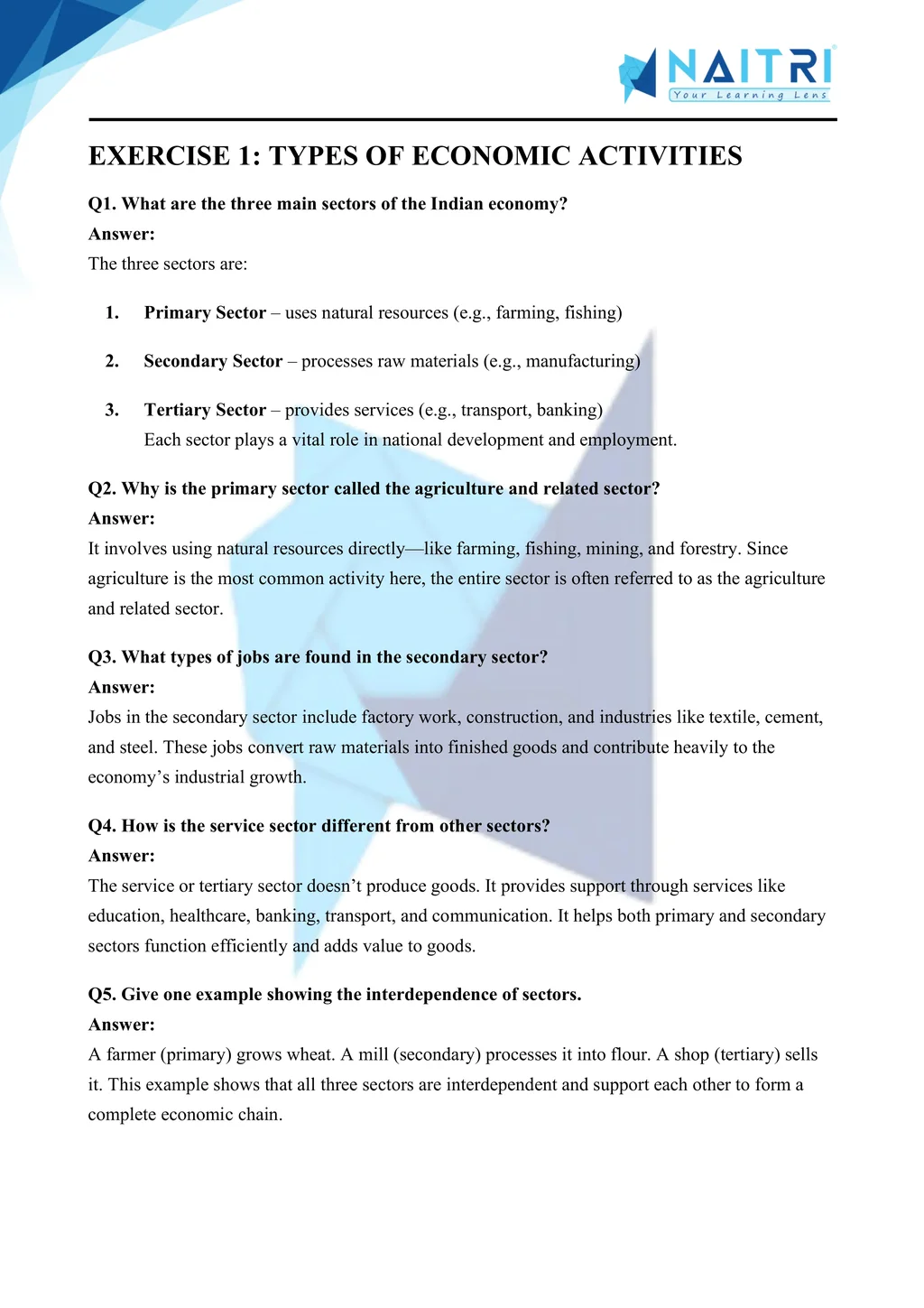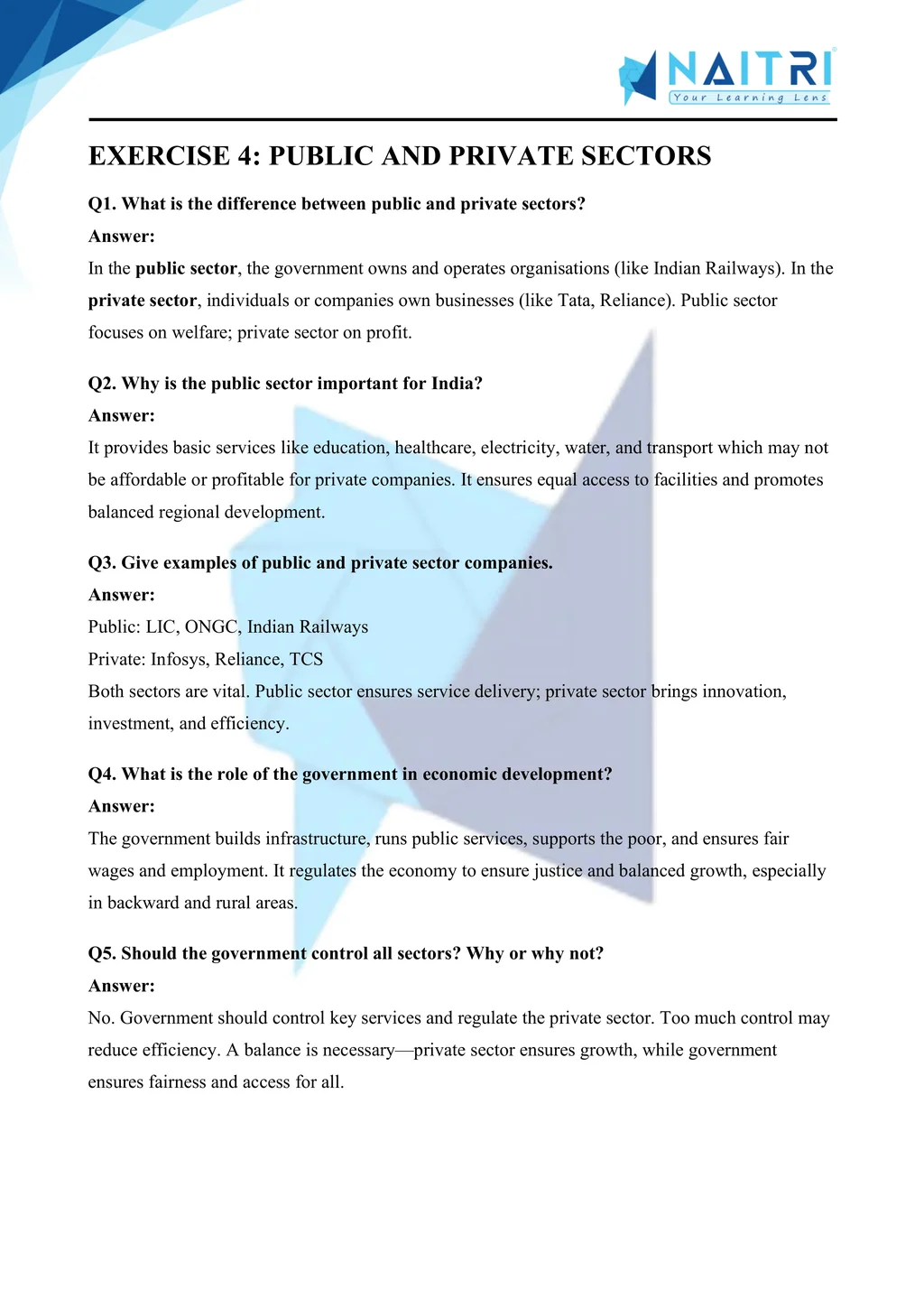NCERT Solutions for Class 10 Economics Chapter 2 – Sectors of Indian Economy
NCERT Solutions for Class 10 Economics Chapter 2 – Sectors of Indian Economy are essential for understanding the structure and functioning of different economic sectors in the CBSE curriculum. These well-structured answers help students grasp topics like primary, secondary, and tertiary sectors, organised vs unorganised sectors, and government intervention. Designed as per the latest syllabus, these solutions strengthen conceptual clarity and improve exam preparation. Ideal for revision and practice, they build foundational knowledge of economic systems, making them a valuable study tool for scoring well in Class 10 Social Science exams.
NCERT Solutions For Class 10 Economics – Sectors of Indian Economy – Exercise Images





Experience Economics Like Never Before – With AR!
Understanding Sectors of Indian Economy is now more exciting and immersive! With the NAITRI App, you can explore complex economics concepts through Augmented Reality (AR). Watch primary, secondary, and tertiary sectors function and evolve in a growing economy — right in front of you. Our AR-powered lessons make learning interactive, 3D, and fun, helping you retain concepts better and enjoy every topic.



Visualize . Interact . Understand . The future of learning is here
Sectors of Indian Economy – Important Questions with Answers
What are the three main sectors of the Indian economy?
Answer: The economy is divided into Primary (agriculture), Secondary (industry), and Tertiary (services) sectors based on the type of activities performed.What is the primary sector?
Answer: It includes activities like farming, fishing, forestry, and mining, which directly use natural resources and form the foundation of our economy.Define the secondary sector.
Answer: The secondary sector involves manufacturing and processing, where raw materials are transformed into finished goods like cloth, cars, and furniture.What is the tertiary sector?
Answer: Also called the service sector, it includes services like banking, education, transport, and healthcare that support the primary and secondary sectors.Why is the primary sector called agriculture and allied sector?
Answer: Because it includes not only crop production but also animal husbandry, dairy, fishing, and forestry, which are allied to agriculture.Why is the tertiary sector gaining importance in India?
Answer: With economic growth, demand for services like IT, transport, finance, and education has increased, making the tertiary sector dominant.What is GDP?
Answer: Gross Domestic Product (GDP) is the total value of all goods and services produced within a country during a specific financial year.Which sector contributes most to India’s GDP today?
Answer: The tertiary sector currently contributes the most to India’s GDP, showing the growing importance of service-related activities.Which sector employs the most people in India?
Answer: The primary sector still employs the largest number of people, though it contributes less to the GDP, showing low productivity.What is underemployment?
Answer: It is a condition where people are working below their potential, like too many workers doing a job that needs only a few.Give an example of underemployment.
Answer: A family of five working on a small farm that needs only two people. The rest are disguisedly unemployed or underemployed.What is the problem with employment in the primary sector?
Answer: Most workers in this sector face underemployment, low income, lack of job security, and are often involved in seasonal work.How can employment be increased in rural areas?
Answer: By investing in irrigation, transport, storage, agro-processing, and encouraging non-farm activities like dairying and handloom.What is the difference between organized and unorganized sector?
Answer: Organized sector offers fixed working hours, job security, and benefits. Unorganized sector lacks these facilities and offers irregular employment.Give two features of the organized sector.
Answer: Workers get regular salary, health benefits, paid leaves, and are covered by labour laws ensuring job security.What is the unorganized sector?
Answer: It consists of small and scattered enterprises with no fixed working hours, no job security, and often low wages.Why do more people work in the unorganized sector?
Answer: Due to lack of education, skills, and opportunities, many people work in informal jobs for survival, despite poor conditions.What steps can be taken to improve the unorganized sector?
Answer: Government should provide skill training, loans, legal rights, and social security schemes like health insurance and pensions.What is the role of the government in employment generation?
Answer: The government creates jobs by investing in infrastructure, welfare schemes, public services, and supporting industries through subsidies and incentives.What is NREGA (MGNREGA)?
Answer: It is a government scheme guaranteeing 100 days of wage employment annually to rural households, aiming to reduce unemployment.Why are public services important?
Answer: Services like education, healthcare, transport, law and order are essential for every citizen and are provided mostly by the government.What is the difference between public and private sectors?
Answer: The public sector is owned and operated by the government. The private sector is run by individuals or companies for profit.Give examples of public sector enterprises.
Answer: Indian Railways, BSNL, ONGC, and government schools are run by the public sector to provide basic services to all.Why does the government support the public sector?
Answer: To ensure equity, basic facilities, job security, and to provide essential services that may not be profitable for the private sector.Summarise the importance of all three sectors.
Answer: The primary sector provides raw materials, the secondary sector adds value by manufacturing, and the tertiary sector supports both with services, forming a balanced economy.
Sectors of the Indian Economy classifies economic activities into primary, secondary, and tertiary sectors. It explains the contribution of each sector to India’s GDP and employment. Students learn about organized and unorganized sectors, public and private sectors, and the importance of government intervention in job creation and worker protection. The chapter builds understanding of India’s economic structure and employment trends.
Download Naitri App
Easy, Visual Learning — Right on Your Phone
Learn with Augmented Reality! The Naitri app makes CBSE and MP Board concepts interactive and fun — even in low-resource settings. Watch lessons, complete homework, take tests, and track progress — all in one place. Anytime. Anywhere.
Available on








